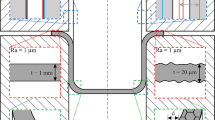Abstract
In precision machining of complex curved surface parts with high performance, geometry accuracy is not the only constraint, but the performance should also be met. Performance of this kind of parts is closely related to the geometrical and physical parameters, so the final actual size and shape are affected by multiple source constraints, such as geometry, physics, and performance. These parts are rather difficult to be manufactured and new manufacturing method according to performance requirement is urgently needed. Based on performance and manufacturing requirements for complex curved surface parts, a new classification method is proposed, which divided the complex curved surface parts into two categories: surface re-design complex curved surface parts with multi-source constraints(PRCS) and surface unique complex curved surface parts with pure geometric constraints(PUCS). A correlation model is constructed between the performance and multi-source constraints for PRCS, which reveals the correlation between the performance and multi-source constraints. A re-design method is also developed. Through solving the correlation model of the typical part’s performance-associated surface, the mapping relation between the performance-associated surface and the related removal amount is obtained. The explicit correlation model and the method for the corresponding related removal amount of the performance-associated surface are built based on the classification of surface re-design complex curved surface parts with multi-source constraints. Research results have been used in the actual processing of the typical parts such as radome, common bottom components, nozzle, et al., which shows improved efficiency and accuracy of the precision machining for the surface re-design parts with complex curved surface.
Similar content being viewed by others
References
GUO Dongming. Function-geometry integrated precision machining methods and technologies for high performance workpieces[J]. Chinese Engineering Science, 2011, 13(10): 47–57.
JIA Zhenyuan, GUO Qiang, SUN Yuwen, et al. Redesigned surface based machining strategy and method in peripheral milling of thin-walled parts[J]. Chinese Journal of Mechanical Engineering, 2010, 23(3): 282–287.
SENOOENOO S, OGATA K, NAKAMURA T. Three-dimensional design method for long blades of steam turbines using fourth-degree nurbs surface[C]//Proceedings of the ASME turbo expo: Power for Land, Sea and Air, Glasgow, UK, June 14–18, 2010: 2149–2158.
CHENG C W, TSENG W P. Design and implementation of a real-time NURBS surface interpolator[J]. International of Advanced Manufacturing Technology, 2006, 30(1–2): 98–104.
WU Xuemei, LI Guixian, ZHAO Weimin, et al. Analysis and study of data processing technique of complex surface based on three-coordinate measurement machine[J]. Chinese Journal of Mechanical Engineering, 2004, 17(4): 390–394.
WU Shixiong, WANG Chengyong, CHEN Zicen. Generate triangulated surfaces from massive unorganized points[J]. Chinese Journal of Mechanical Engineering, 2006, 19(1): 93–95.
SUN Yuwen, WANG Yuechao, LIU Weijun. Free-form surface reconstruction based on NURBS to serial cross-sections[J]. Chinese Journal of Mechanical Engineering, 2003, 16(4): 420–423.
SUN Yuwen, LIU Jian, LIU Weijun. Research on rapid prototyping-oriented reconstruction technique of complex surfaces[J]. Chinese Journal of Mechanical Engineering, 2001, 37(9): 62–66. (in Chinese)
PENG Wangze. Air defense missile radome[M]. Beijing: Astronautics Press, 1993.
GUO Dongming, LOU Xin, WANG Xiaoming, et al. Reconstruction of the 3D surface for precision machining of missile radome[J]. Chinese Journal of Mechanical Engineering, 2001, 37(9): 92–95. (in Chinese)
WANG Xiaoping, ZHOU Rurong, YE Zhenglin, et al. Periodic deformation of parametric surface[J]. Chinese Journal of Mechanical Engineering, 2004, 17(3): 394–398.
KRIMPENIS A, FOUSEKIS A, VOSNIAKOS G. Assessment of sculptured surface milling strategies using design of experiments[J]. International of Advanced Manufacturing Technology, 2005, 25(5–6): 444–453.
LEE Y T, FANG L. Accurate modelling of complex functional surfaces for mechanical design using freeform surfaces[J]. Journal of Mechanical Design, 2000, 122(2): 236–239.
BIAN Keke, KE Yinglin. Global continuity adjustment and local shape optimization technique for complex trimmed surface model[J]. Chinese Journal of Mechanical Engineering, 2010, 23(2): 225–232.
WU Shixiong, WANG Wen, CHEN Zichen. Adaptive measurement method based on changing-curvature for unknown free-form[J]. Chinese Journal of Mechanical Engineering, 2004, 17(3): 385–388.
Author information
Authors and Affiliations
Corresponding author
Additional information
This project is supported by Key Program of National Natural Science Foundation of China(Grant No. 50835001), and Program for New Century Excellent Talents in University, China(Grant No. NCET-13-0081)
JIA Zhenyuan, born in 1963, is currently a professor at Institute of Advanced Manufacturing Technology, the director of Key Laboratory for Precision and Non-traditional Machining Technology of Ministry of Education, and the dean of School of Mechanical Engineering, Dalian University of Technology, China. He received his PhD degree from Dalian University of Technology, China, in 1990. His research interests include precision machining, precision measurement, function material component and process detection.
WANG Fuji, born in 1974, is currently an associate professor at Dalian University of Technology, China. He received his PhD degree from Dalian University of Technology, China, in 2005. His research interests include precision machining, precision measurement, function material component and artificial intelligence.
WANG Yongqing, born in 1969, a professor at Dalian University of Technology, China. He received his PhD degree from Dalian University of Technology, China, in 2002. His research interests include numerical control technology, digital manufacturing, and precision measurement.
GUO Dongming, born in 1959, is currently an academician of China Engineering Academy, the executive vice president of Dalian University of Technology, China. His main research interests include special machining, precision/ultra-precision machining technology.
Rights and permissions
About this article
Cite this article
Jia, Z., Wang, F., Wang, Y. et al. Explicit correlation model of multi-source constraints for Re-design parts with complex curved surface. Chin. J. Mech. Eng. 27, 385–391 (2014). https://doi.org/10.3901/CJME.2014.02.385
Received:
Revised:
Accepted:
Published:
Issue Date:
DOI: https://doi.org/10.3901/CJME.2014.02.385




